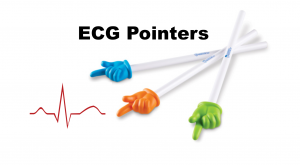Today on the emDOCs cast Brit Long interviews Zachary Aust on the use of a mental model in post ROSC patients.
Episode 98: Post ROSC Mental Model
What’s the problem?
- The Code
- Whatever caused the initial arrest
- Iatrogenic injuries from CPR
- Patients are in a pathophysiologic state that is being called “post-cardiac arrest syndrome”
- Hypoxic brain injury
- Myocardial dysfunction
- Systemic ischemia/reperfusion injury
- SIRS Response
- Very fragile state
- Hard to diagnose what is going on
- Small Things Matter
Overview – C A B S
- Circulation
- Close monitoring of perfusion
- Arterial Line
- US/Doppler
- Pulse Ox
- ETCO2
- Higher MAP with Immediate Vasopressors + Fluids
- Norepinephrine or Epinephrine
- Airway
- Definitive Airway (before they leave)
- Resus Before Intubation
- Use Induction+Paralytic
- Inline Waveform ETCO2
- Breathing
- Keep things normal (O2/CO2)
- Be Mindful of Over-bagging
- Stuff
- EKG
- POCUS-RUSH
- Temp
- Use a checklist to remember the little things
Circulation
- Multi Modal Perfusion Markers
- Arterial Line
- Femoral site preferred
- Don’t lose focus on the resus
- Ultrasound
- Pulsatile carotid/femoral
- Transition to doppler after ensuring correct vessel
- Femoral vein pulsatile during CPR
- Pulse Ox
- Persistent waveform
- Good indicator of mechanical HR
- Persistent waveform
- End Tidal Capnography
- Persistent elevation > 30-40
- Arterial Line
- Check Heart Rate and Blood pressure
- MAP Goal: 80 mm Hg
- Consider >65 if severe myocardial dysfunction but in general higher MAP
- Hypotension- need to find out why but empirically treat at the same time
- Vasopressors immediately-Have at beside ready….or running during code
- Norepinephrine is good default
- Epi
- Better for PE
- Not for VTach/VFib
- Vasopressin- especially if super acidotic
- Dopamine-Just say no
- Vasopressors immediately-Have at beside ready….or running during code
- RUSH Exam-find out why they are hypotensive
- Rule Out PTX/Tamponade
- RVD can be from code itself
- Myocardial dysfunction from etiology or post cardiac arrest syndrome
- Serial assessments
- Probably 1-2 L IVF up front, don’t blindly administer massive amounts of fluid
- Bradycardia- check BP
- HTN- likely appropriate response, monitor closely can drop soon
- Hypotensive- see above
- If you think the bradycardia is driving the hypotension sure try atropine
- But get the epi/pacing ready
Airway
- If no ETT/definitive airway they need one….not the biggest priority (focus on circulation) but sooner rather than later…before they leave the room for sure
- Remember it’s okay to use LMA during code but be using…
- ETCO2 In Line Waveform
- No ETCO2 reading? Check the pulse
- RSI= Resuscitation Sequence Intubation
- Hypoxia, Hypotension, and Acidosis are the reason patients code during/post intubation
- These patients are super high risk for all 4
- Optimize first pass success – Induction agent + paralytic
- Unconscious patients will still have muscle tone
- Induction
- Ketamine or Etomidate at half doses (i.e., Ketamine 50 mg IV)
- Paralytic-double the dose
- Rocuronium is my choice
- Unlikely to know true potassium given ischemia/reperfusion
- Rocuronium is my choice
- Post Intubation analgesia/sedation
- Patients can have awareness post ROSC
- Also need to consider neuro prognostication
- Short acting agents
- Use ketamine drip if it’s an option
- Can re-dose Ketamine/Etomidate (easy to forget however)
- Propofol with a pressor less optimal here in the immediate period but once stabilized a good option
- Fentanyl
- Pushes
- May not be ideal for drip as it can build up but okay to start while in ED if stopping before before leaving for ICU
- Please stop using versed drips for post intubation sedation
- NG/OG tube and HOB elevated
Breathing
- Overview
- Target normoxia and normocapnia
- Target a SpO2 of 92-95% (PaO2 80-150)
- ETCO2 30-35 (PaCO2 35-45)
- Oxygen
- Avoid both hypoxia and hyperoxia (remember the little things)
- Target a SpO2 of 92-95%
- Titrate down FiO2 to the minimum for this and as quickly as you can
- Don’t need blood gas to do this
- CO2
- Avoid hypocapnia (decreased brain perfusion)
- Unclear if hypercapnia is beneficial, avoid until more date
- Verify with blood gas as needed BUT remember the ETCO2 is AT LEAST what our PaCO2 is
- Use lung protective settings unless asthmatic/COPD
- Over-bagging with BVM is common; will cause decrease venous return
Stuff (workup/imaging/other meds)
- Utilize a physical checklist here
- My preferred at this time linked in chapter above
- EKG ASAP
- POCUS-RUSH as above
- POC Glucose
- Broad workup
- Basics+coags, trops, thyroid, pregnancy
- Low threshold for sepsis add ons +abx
- Steroids – controversial
- CT- if unknown cause consider strongly
- If they go I panscan for etiology and sequelae of CPR
- CT Head
- Some evidence that may show benefit with unknown story…I would lean towards getting one
- CT chest-PE/dissection
- May have clues on POCUS first
- CT abdomen/pelvis
- Find the source of sepsis
- CT Head
Targeted Temperature Management
- My goal: Temp < 37.8 C
- General principle of avoiding fever
- Local guidelines will be the biggest influence
- Evolving evidence
- Continuous monitoring
- Scheduled acetaminophen
- Devices to cool depend on institution
- Don’t over focus on this at expense of other things keep the fever down and working in conjunction with the admitting providers
Cath Lab
- ROSC+STEMI= Cath Lab
- AHA/ACC Class I rec
- ROSC + No STEMI= Trend EKGs
- 2014 AHA/ACC guidelines-patient with hemodynamic/electrical instability-
- Immediate invasive strategy within 2 hours- Class Ia
- Dependent on patient factors + conversation with interventional cardiology
- Patient factors to consider
- Witnessed or unwitnessed arrest, non shockable initial rhythm, bystander CPR, 30 min until ROSC, pH < 7.2, Lactate >7, age >85, ESRD, non cardiac causes likely
- Be cautious using pH and Lactate in isolation without other factors
- Patient factors to consider







1 thought on “emDOCs Podcast – Episode 98: Post ROSC Mental Model”
This is a great mental model!
I’m not sure the MAP goal should be > 80 mmHg post arrest. This is not zero risk if having to use catecholamines to achieve a higher MAP target. The latest RCT (https://www.nejm.org/doi/full/10.1056/NEJMoa2208687) demonstrates a MAP of 63 has equivalent mortality and neurologic outcomes (even in the pre-existing hypertension subgroup) to a MAP of 77.
My goal is MAP > 65 post arrest